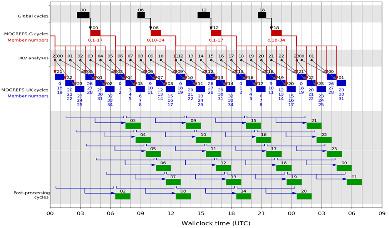当前位置:
X-MOL 学术
›
Q. J. R. Meteorol. Soc.
›
论文详情
Our official English website, www.x-mol.net, welcomes your feedback! (Note: you will need to create a separate account there.)
Recent upgrades to the Met Office convective‐scale ensemble: An hourly time‐lagged 5‐day ensemble
Quarterly Journal of the Royal Meteorological Society ( IF 8.9 ) Pub Date : 2020-06-04 , DOI: 10.1002/qj.3844 Aurore N. Porson 1 , Joanne M. Carr 2 , Susanna Hagelin 2, 3 , Rob Darvell 2 , Rachel North 2 , David Walters 2 , Kenneth R. Mylne 2 , Marion P. Mittermaier 2 , Steve Willington 2 , Bruce Macpherson 2
Quarterly Journal of the Royal Meteorological Society ( IF 8.9 ) Pub Date : 2020-06-04 , DOI: 10.1002/qj.3844 Aurore N. Porson 1 , Joanne M. Carr 2 , Susanna Hagelin 2, 3 , Rob Darvell 2 , Rachel North 2 , David Walters 2 , Kenneth R. Mylne 2 , Marion P. Mittermaier 2 , Steve Willington 2 , Bruce Macpherson 2
Affiliation

|
In this article, we introduce a new configuration of the Met Office convective‐scale ensemble for numerical weather prediction, for the Met Office Global and Regional Ensemble Prediction System over the United Kingdom (MOGREPS‐UK). The new version, which became operational in March 2019, uses an hourly time‐lagged configuration to take advantage of the hourly 4D‐Var data assimilation run in the deterministic UK model with variable horizontal resolution, the UKV. An 18‐member ensemble is created by running three members every hour and time‐lagging these over a 6 hr window. This configuration is compared against the previous operational configuration, a 6‐hourly convective‐scale ensemble running 12 members. The main benefits of the time‐lagged ensemble are to increase the ensemble size, to add small‐scale uncertainties in the initial conditions and to generate more timely forecasts. The time‐lagged configuration is shown to objectively improve the forecast at all lead times, with larger improvements in the first few hours. The improvement is seen in the ranked probability scores and is mainly associated with the improvements in the spread of the ensemble with an increase of about 5 to 10% in both summer and winter seasons. A larger ensemble size is necessary in the time‐lagged configuration for it to outperform or maintain as good a performance against the previous 6‐hourly configuration for all lead times. Alongside the update to an hourly configuration, the forecast length is more than doubled to 120 hr. Objective verification shows that the time‐lagged configuration performs better than the high‐resolution deterministic, UKV, and the global ensemble, MOGREPS‐G, up to T + 120 hr. Increasing the size of the time‐lagged ensemble through lagging over additional cycles leads to small but significant improvements, larger in most cases than those that can be obtained through neighbourhood processing.
中文翻译:

美国气象局对流规模合奏的最新升级:时滞5天的每小时合奏
在本文中,我们为英国气象局全球和区域合奏预报系统(MOGREPS-UK)介绍了气象局对流尺度集合的新配置,用于数值天气预报。新版本已于2019年3月投入使用,它使用每小时时滞配置,以利用在确定性UK模型中运行的每小时4D-Var数据同化功能的水平分辨率UKV。通过每小时运行三个成员并在6小时的时间间隔内将它们延迟来创建18个成员的集合。将此配置与之前的运行配置(一个运行12个成员的6小时对流规模集合)进行了比较。时滞合奏的主要好处是可以增加合奏的大小,在初始条件下增加小规模的不确定性,并产生更及时的预测。滞后配置显示出可以在所有交付时间客观地改善预测,并且在最初几个小时内可以进行更大的改进。在排名的概率分数中可以看到这种改善,这主要与整体传播的改善有关,夏季和冬季都增加了约5%到10%。在时滞配置中,必须有更大的集成大小,以使其在所有交付时间内都优于或保持以前的6小时配置的性能。除了更新为每小时配置外,预测长度也增加了一倍以上,达到120小时。客观验证表明,时滞配置的性能优于高分辨率确定性UKV,以及全球合奏MOGREPS‐G,最高T + 120小时。通过滞后附加周期来增加具有时间滞后的集合的大小,这会导致微小但显着的改进,在大多数情况下,这些改进要比通过邻域处理获得的结果大。
更新日期:2020-06-04
中文翻译:

美国气象局对流规模合奏的最新升级:时滞5天的每小时合奏
在本文中,我们为英国气象局全球和区域合奏预报系统(MOGREPS-UK)介绍了气象局对流尺度集合的新配置,用于数值天气预报。新版本已于2019年3月投入使用,它使用每小时时滞配置,以利用在确定性UK模型中运行的每小时4D-Var数据同化功能的水平分辨率UKV。通过每小时运行三个成员并在6小时的时间间隔内将它们延迟来创建18个成员的集合。将此配置与之前的运行配置(一个运行12个成员的6小时对流规模集合)进行了比较。时滞合奏的主要好处是可以增加合奏的大小,在初始条件下增加小规模的不确定性,并产生更及时的预测。滞后配置显示出可以在所有交付时间客观地改善预测,并且在最初几个小时内可以进行更大的改进。在排名的概率分数中可以看到这种改善,这主要与整体传播的改善有关,夏季和冬季都增加了约5%到10%。在时滞配置中,必须有更大的集成大小,以使其在所有交付时间内都优于或保持以前的6小时配置的性能。除了更新为每小时配置外,预测长度也增加了一倍以上,达到120小时。客观验证表明,时滞配置的性能优于高分辨率确定性UKV,以及全球合奏MOGREPS‐G,最高T + 120小时。通过滞后附加周期来增加具有时间滞后的集合的大小,这会导致微小但显着的改进,在大多数情况下,这些改进要比通过邻域处理获得的结果大。



























 京公网安备 11010802027423号
京公网安备 11010802027423号